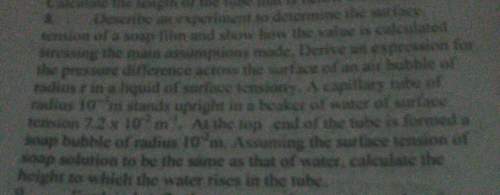
Physics, 27.02.2020 02:24 mamas12345
An m = 20.0 g object is held against the free end of a spring of constant k = 25.0 N / m that is compressed a distance x = 10.0 cm from its equilibrium length. Once released, the object slides d 1 = 1.15 m across the tabletop and eventually lands d 2 = 0.2 m from the edge of the table on the floor, as shown in the figure. Calculate the coefficient of friction μ between the table and the object. The sliding distance includes the compression of the spring, and the tabletop is h = 1.00 m above the floor level.

Answers: 3


Another question on Physics

Physics, 21.06.2019 20:30
What property is a characteristic of a substance that can be observed and does not change the identity of the substance
Answers: 2

Physics, 22.06.2019 06:20
Atwo-stage air compressor operates at steady state, compression 10m^3/min of air from 100 kpa and 300k to 1200 kpa. an intercooler between the two stages cools the air to 300k at a constant pressure of 350 kpa. the compression processes are isentropic. a) calculate the power required to run the compressor, in kw b) compare the result to the power required for isentropic compression from the same inlet state to the same final pressure.
Answers: 1

Physics, 22.06.2019 08:00
Aheat engine running backward is called a refrigerator if its purpose is to extract heat from a cold reservoir. the same engine running backward is called a heat pump if its purpose is to exhaust warm air into the hot reservoir. heat pumps are widely used for home heating. you can think of a heat pump as a refrigerator that is cooling the already cold outdoors and, with its exhaust heat qh, warming the indoors. perhaps this seems a little silly, but consider the following. electricity can be directly used to heat a home by passing an electric current through a heating coil. this is a direct, 100% conversion of work to heat. that is, 19.0 \rm kw of electric power (generated by doing work at the rate 19.0 kj/s at the power plant) produces heat energy inside the home at a rate of 19.0 kj/s. suppose that the neighbor's home has a heat pump with a coefficient of performance of 4.00, a realistic value. note: with a refrigerator, "what you get" is heat removed. but with a heat pump, "what you get" is heat delivered. so the coefficient of performance of a heat pump is k=qh/win. an average price for electricity is about 40 mj per dollar. a furnace or heat pump will run typically 200 hours per month during the winter. what does one month's heating cost in the home with a 16.0 kw electric heater? what does one month's heating cost in the home of a neighbor who uses a heat pump to provide the same amount of heating?
Answers: 2

Physics, 22.06.2019 11:00
1. jay fills a wagon with sand (about 20 kg) and pulls it with a rope 30 m along the beach. he holds the rope 25° above the horizontal. the rope exerts a 20-n tension force on the wagon. how much work does the rope do on the wagon?
Answers: 1
You know the right answer?
An m = 20.0 g object is held against the free end of a spring of constant k = 25.0 N / m that is com...
Questions


Physics, 20.09.2020 15:01



Computers and Technology, 20.09.2020 15:01


Computers and Technology, 20.09.2020 15:01



Mathematics, 20.09.2020 15:01

Mathematics, 20.09.2020 15:01






Mathematics, 20.09.2020 15:01

Mathematics, 20.09.2020 15:01

Computers and Technology, 20.09.2020 15:01










